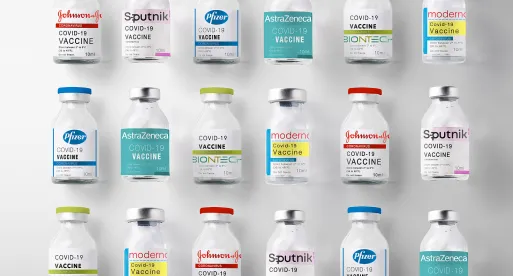On September 24, 2021, the Safer Federal Workforce Task Force (the “Task Force”) issued Guidance for Federal Contractors and Subcontractors (the “Guidance”), advising covered federal contractors and subcontractors of their new COVID-19 safety requirements. The Guidance, which still must be approved by the Office of Management and Budget, fleshes out the requirements set forth in Executive Order 14042 (the “Executive Order”) which announced that certain contractors with new contract or contract-like instruments (and their subcontractors) will be subject to COVID-19 safety requirements. Our discussion of the Executive Order is available here.
The Guidance provides that covered federal contractors and subcontractors (“Contractors”) will be required to (1) impose vaccination requirements on certain employees; (2) comply with masking and physical distancing requirements, and (3) designate person(s) to coordinate COVID-19 workplace safety efforts.
The Guidance is subject to change based on new Centers for Disease Control and Prevention (“CDC”) guidance “and as warranted by the circumstances of the pandemic and public health conditions.” When such changes are made, they will automatically be imposed on covered Contractors.
Some key details from the Guidance are provided below:
Which Contractors Are Subject to the New Requirements?
Covered Contractors are those who enter into a new contract or contract-like instrument that contains a clause incorporating the Guidance, which is to be developed by October 8, 2021 by the Federal Acquisition Regulatory Council (“FAR Council”) prior to a formal rulemaking. The new requirements must be incorporated into covered[1] contracts awarded prior to October 15, 2021 whenever an option is exercised or an extension is made. The new clause will have to be incorporated into covered contracts awarded on or after November 14, 2021; for covered contracts awarded between October 15 and November 14, 2021, agencies are encouraged to include the clause but are not required to do so except where the solicitation for the contract was issued on or after October 15, 2021. Prime contractors must also include flow-down provisions incorporating the clause into subcontracts, which must flow the clause down to all lower-tier subcontractors.
Small businesses will not be exempted from the requirement. As reflected in the Task Force’s previously issued guidance, reported on here, even though the Executive Order expressly excludes specific types of contracts, the Guidance “strongly encourages” agencies to incorporate the Guidance into contracts not covered by the Executive Order. As the Guidance states:
“Consistent with applicable law, agencies are strongly encouraged to incorporate a clause requiring compliance with this Guidance into contracts that are not covered or directly addressed by the order because the contract is under the Simplified Acquisition Threshold … or is a contract or subcontract for the manufacturing of products. Agencies are also strongly encouraged to incorporate a clause requiring compliance with this Guidance into existing contracts and contract-like instruments prior to the date upon which the order requires inclusion of the clause.”
What Are The Requirements?
-
Vaccinations.
-
Required employee vaccinations: All covered employees are required to be vaccinated for COVID-19, except where an accommodation is required due to a disability or the agency has “an urgent, mission-critical need” to have an employee begin work on a covered contract at a covered workplace prior to becoming fully vaccinated. There is no exception for employees who have had a prior COVID-19 infection. There is no testing requirement in the Guidance for employees who receive an exception.
-
Deadline for vaccination compliance: Non-exempted employees must be fully vaccinated by December 8, 2021, or “by the first day of the period of performance on a newly awarded covered contract, and by the first day of the period of performance on an exercised option or extended or renewed contract when the clause has been incorporated into the covered contract.” Consistent with guidance from the CDC, individuals are fully vaccinated if two weeks have passed since they “received the second dose in a two-dose series, or two weeks after they have received a single-dose vaccine.” The Guidance discusses which vaccines are acceptable. It also notes that “[t]here is currently no post-vaccination time limit on fully vaccinated status; should such a limit be determined by the [CDC], that limit will be considered by the Task Force and OMB for possible updating of this Guidance.”
-
Verification of compliance: Contractors must review employee vaccination documentation to confirm their employees meet the vaccination requirement. Acceptable forms of documentation are “a copy of the record of immunization from a health care provider or pharmacy, a copy of the COVID-19 Vaccination Record Card (CDC Form MLS-319813_r, published on September 3, 2020), a copy of medical records documenting the vaccination, a copy of immunization records from a public health or State immunization information system, or a copy of any other official documentation verifying vaccination with information on the vaccine name, date(s) of administration, and the name of health care professional or clinic site administering vaccine.” Helpfully, the Guidance expressly provides that a “digital copy of such records, including, for example, a digital photograph, scanned image, or PDF of such a record” is acceptable. A recent antibody test is not sufficient proof of vaccination status.
-
Employees exempted from the vaccination requirement: In addition to the “urgent, mission-critical” exception noted above (which can only have a temporary duration), the Guidance provides that Contractors “may be required to provide an accommodation to covered contractor employees who communicate to the covered contractor that they are not vaccinated against COVID-19 because of a disability (which would include medical conditions) or because of a sincerely held religious belief, practice, or observance. A covered contractor should review and consider what, if any, accommodation it must offer. Requests for ‘medical accommodation’ or ‘medical exceptions’ should be treated as requests for a disability accommodation.” (emphases added). The Guidance provides no further information regarding how such accommodation requests should be assessed, through a prior Task Force publication suggested further guidance on this subject will be forthcoming.
-
-
Masking and Social Distancing. Although coverage of the Executive Order focused on the likely vaccine requirement, the Guidance also lays out masking and social distancing requirements. In addition to following CDC guidelines, covered Contractors will be required to adhere to the following protocols:
-
Masks are required: (1) indoors in areas of high and substantial community transmission for all employees (regardless of vaccination status); (2) for non-fully vaccinated employees indoors in areas of moderate and low transmission; and (3) for non-fully vaccinated employees in “crowded outdoor settings or during outdoor activities that involve sustained close contact with other people who are not fully vaccinated.” Where masks are required, they must be worn “consistently and correctly.”
-
Masks are not required: for fully vaccinated employees indoors in areas of moderate and low transmission and in outdoor spaces. Contractors can also provide exceptions from masking requirements where consistent with CDC guidelines (such as where the employee is alone in an enclosed personal office or for a limited time while eating or drinking). Other exceptions based on the activities the employee engages in or other factors may also be available, but must be determined by a workplace risk assessment and approved in writing by a “duly authorized representative” of the Contractor.
-
The Guidance recognizes exceptions to masking requirements may be required due to disability or religious accommodations, but notes providing accommodations may not always be required: “A covered contractor should review [accommodation requests] and consider what, if any, accommodation it must offer.”
-
Contractors must refer to the CDC COVID-19 Data Tracker County View website to determine the level of community transmission “in all areas where they have a covered contractor workplace at least weekly to determine proper workplace safety protocols.” When the level increases from low/moderate transmission to substantial or high, the Contractor “should put in place more protective safety protocols,” but when the level is reduced, the Contractor cannot reduce the level of safety protocols unless and until the transmission rate remains at the lower level for at least two consecutive weeks.
-
-
Social distancing of six-feet or more is required “[t]o the extent practicable” for non-fully vaccinated employees, “including in offices, conference rooms, and all other communal and work spaces.”
-
Social distancing is not required for fully vaccinated employees, and for situations where the contractor provides exceptions consistent with CDC guidelines (such as where the employee is alone in an enclosed personal office or for a limited time while eating or drinking).
-
-
Designation of COVID-19 Workplace Safety Coordinator. Covered Contractors are required to designate a person(s) to “coordinate implementation of and compliance with this Guidance and the workplace safety protocols detailed herein at covered contractor workplaces.” This person(s) must “ensure that information on required COVID-19 workplace safety protocols is provided to covered contractor employees and all other individuals likely to be present at covered contractor workplaces.” They “must also ensure that covered contractor employees comply with the requirements in this guidance related to the showing or provision of proper vaccination documentation.”
-
What Locations and Employees Are Subject to the Requirements?
As suggested by the Executive Order, the new requirements will apply to covered Contractor workplaces. The Guidance defines such “covered contractor workplaces” as “a location controlled by a covered contractor at which any employee of a covered contractor working on or in connection with a covered contract is likely to be present during the period of performance for a covered contract. A covered contractor workplace does not include a covered contractor employee’s residence.” (emphasis added). Therefore, all employees, whether or not they work on or in connection with a covered contract, will be subject to the requirements if anyone at their workplace works on or in connection with a covered contract or is likely to be present at their workplace during the applicable contract’s performance period. Further, employees who work on or in connection with a covered contract – regardless of whether they work in a covered contractor workplace – must comply with the vaccination requirement even if they perform their work remotely.
The guidance includes a set of Frequently Asked Questions (“FAQs”) which provides additional detail. For example:
-
Covered workplaces include outdoor workplace locations.
-
Where employees working on or in connection with a covered contract work on only one floor or area of a workplace (including a building/site/facility on a larger Contractor-controlled campus), the requirements will still apply to all employees at the worksite unless the Contractor “can affirmatively determine that none of its employees on another floor or in separate areas of the building will come into contact with a covered contractor employee during the period of performance of a covered contract … including interactions through use of common areas such as lobbies, security clearance areas, elevators, stairwells, meeting rooms, kitchens, dining areas, and parking garages.”
-
Employees working “in connection with” a covered contract are those “who perform duties necessary to the performance of the covered contract, but who are not directly engaged in performing the specific work called for by the covered contract, such as human resources, billing, and legal review.” The FAQ includes no threshold for the amount of “connected” work required for such employees to be covered by the requirements.
As noted above, the Guidelines are subject to change and we will report on any noteworthy changes and other developments here. Contractors should become familiar with these requirements and be aware that any new federal government contract, contract extension, or contract renewal will likely include these requirements. Those expecting to be subject to the new requirements should assess which workplaces may be impacted and how the Guidance differs from their current COVID-19 protocols.
[1] As we previously reported, the Executive Order explains that the requirement will apply to a new contract and contract-like instrument if: “(i) it is a procurement contract or contract-like instrument for services, construction, or a leasehold interest in real property; (ii) it is a contract or contract-like instrument for services covered by the Service Contract Act, 41 U.S.C. 6701 et seq.; (iii) it is a contract or contract-like instrument for concessions, including any concessions contract excluded by Department of Labor regulations at 29 C.F.R. 4.133(b); or (iv) it is a contract or contract-like instrument entered into with the Federal Government in connection with Federal property or lands and related to offering services for Federal employees, their dependents, or the general public.”
Per the Executive Order, the new requirement will not apply to “(i) grants; (ii) contracts, contract-like instruments, or agreements with Indian Tribes under the Indian Self-Determination and Education Assistance Act (Public Law 93-638), as amended; (iii) contracts or subcontracts whose value is equal to or less than the simplified acquisition threshold, as that term is defined in section 2.101 of the Federal Acquisition Regulation [generally $250,000]; (iv) employees who perform work outside the United States or its outlying areas, as those terms are defined in section 2.101 of the Federal Acquisition Regulation; or (v) subcontracts solely for the provision of products.” As noted above, even though the Executive Order expressly carves out these contracts from its COVID-19 safety requirement mandate, the Guidelines may still be incorporated into such new contracts and contract-like instruments.




 />i
/>i

